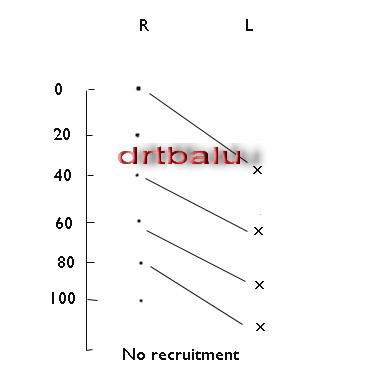Alternate Binaural Loudness Balance Test
History:
This test was first described by Fowler in 1936. This test was introduced to identify the phenomenon of recruitment.
Procedure:
In this test the tone is presented alternately between the two ears. The level of the tone stays the same in one ear (i.e. fixed ear) and is varied up / down in the other ear (i.e. variable ear). The patient is asked to report when the sound is louder in the right ear, louder in the left ear, and when it sounds equal in both ears. Loudness balance is said to have been obtained when the patient indicates that the sound is heard equally in both ears. The tester then records the two levels in dB hearing level where the balance has occurred.
Normal values:
Since ABLB test compares one ear with that of the other, a patient with normal and equal hearing in both ears should have:
| dB right | dB left |
|---|---|
| 0 | 0 |
| 20 | 20 |
| 40 | 40 |
| 60 | 60 |
| 80 | 80 |
| 100 | 100 |
The recorded values can be plotted in different ways. Commonly used plotting methods are:
.Steinberg Gardner plot
.Laddergram
Steinberg Gardner plot:
Here the values are plotted along X and Y axis as shown in the figure below.
Laddergram:
In this type of plotting for each loudness balance, a circle is drawn at the hearing level in the right ear, and an X at the hearing level for left ear. These two symbols are joined by a line to show that they are equally loud. The horizontal lines resembling the rungs of a ladder indicates equal loudness occur at the same intensities in both ears.
Uses:
ABLB test is used clinically to determine whether loudness recruitment is present in the abnormal ear in a patient with unilateral hearing loss. Loudness balances are made between the patient's abnormal ear and normal ear. Normal thresholds are needed in the better ear because ABLB works by comparing loudness between the two ears. The treshold of the abnormal ear should be atleast 35 dB at each frequency used.
Recruitment:
This is defined as a phenomenon in which sounds are heard with equal intensities in the normal and abnormal ears in high intensity levels. The abnormal increase in the sensitivity to increasingloudness of sound in the affected ear is known as recruitment. This phenomenon of recruitment can be used to distinguish between cochlear and retrocochlear deafness. There is recruitment in cochlear deafness while it is absent in retrocochlear deafness.
Various types of recruitment have been documented.
Complete recruitment:
Occurs when the loudness balances at higher levels of intensity levels; for example when the tresholds of good ear is 0 dB and that of the bad ear is 50 dB, yet at 80 dBHL sounded equally in both ears. This is seen as flattening of the laddergram.
Incomplete recruitment:
In this type the results fall between complete recruitment and no recruitment curves. This is seen as partial flattening of the laddergram.
No recruitment:
This occurs when relationship between the levels at 2 ears is the same for loudness balances as it at threshold.
Hyperrecruitment:
Patients with Meniere's disease may exhibit a special case of recruitment in which the loudness in the abnormal ear not only catches up with the normal, but actually overtakes it. This is revealed in the laddergram by rungs that first flatten and then reverses its direction.
Derecruitment:
Loudness grows at a slower than normal rate as intensity increases in the abnormal ear.
Test approach:
Jerger protocol:
In this protocol devised by Jerger tone alters between two ears every 500 milliseconds, with fixed level in abnormal ear and variable signal in the normal ear. Patient changes the intensity of the tone of variable ear until it sounds equal in loudness to the tone in the fixed ear.
The tone alternates between two ears every 500 milliseconds. The tone will be off for 500 milliseconds in each ear. This off time ensures that the test tones will not be subject to adaptation.
Hood's protocol: This protocol uses the good ear as fixed level ear and the bad ear as variable one. This protocol ensures better control by the tester.
Miskolczy - Fodor modification:
In this protocol the level of tone in fixed ear increases over time, so this ear may be considered as the reference ear. The patient uses a Bekesy tracking method to keep the level in the variable ear equally loud as the one in the reference ear. The results are automatically plotted on paper.




